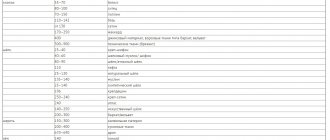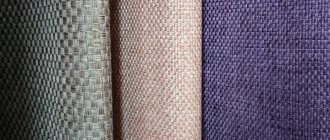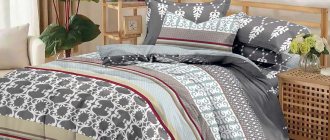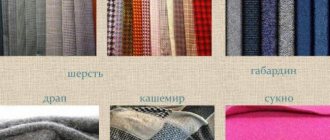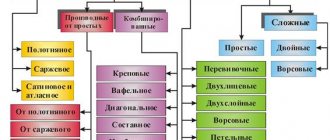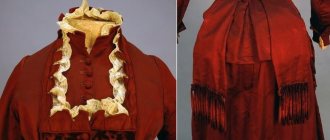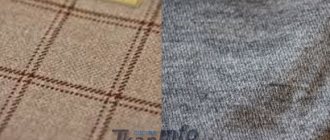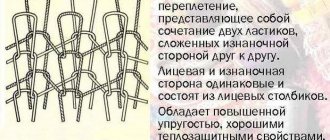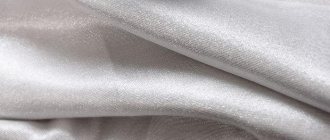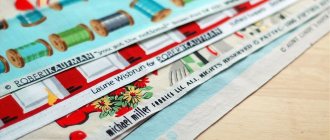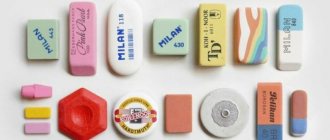When trying to describe eraser fabric, many people confuse it with knitwear due to its supposed high elasticity and stretchability. In fact, this material does not stretch and has nothing in common with knitted fabrics. Today we will tell you about it in detail so that no one else has a similar error. An eraser is a cotton fabric woven with a satin weave that looks very similar to satin. However, there are differences, and they are significant.
What is a fabric eraser? Photo
What kind of fabric
To understand what an eraser is and why it is so good, imagine a dense, silky-to-touch material consisting almost entirely of natural plant (cotton) raw materials. Traditionally, the material is used to make clothing for children or adults, sleeping linen, and other types of textiles for the home and interior.
A little historical background
The name of the fabric is similar to the name of the school eraser - “eraser” and with another textile material - elastic. It is precisely by such associations that the consumer imagines a stretchy, elastic fabric. However, in fact, the material received such a name not at all because of the erasing rubber bands and not because of the ability of rubber or caoutchouc fibers to stretch greatly (which are not included in the composition at all).
In English the word is written lasting, the translation into Russian is “durable”, and this is the main characteristic quality of the material being described. Unlike, for example, the same rib, with which an eraser is often confused, and which, like any knitwear, really stretches well.
Description
To accurately imagine what kind of fabric an eraser is, we offer a detailed description. This is a smooth, durable, pleasant-to-touch textile with a smooth surface. The characteristics correspond to any 100% cotton fabric: hygroscopic, environmentally friendly, hypoallergenic and safe for health.
Differences between cotton and other fabrics
- Combustion.
- All natural materials burn. Mixed ones burn with the formation of a larger or smaller drop of resin. Synthetic fabrics are melted.
- Cotton burns well, giving off a burnt paper smell. At the end of the combustion it smolders.
- Flax also burns well, but smolders much worse.
- Wool burns without smoldering, emitting a specific smell of burnt hair.
- Tactile and visual impressions.
- When touched, cotton feels like a warm, soft, easily wrinkled fabric. It drapes well.
- Linen is shiny, hard, cool, smooth. It drapes poorly and wrinkles very easily.
- Silk is a pleasant, soft, flexible, lightweight material. Doesn't wrinkle.
Cotton fabrics are hygienic, practical, and beautiful. From a wide range of products, you can always choose a comfortable, durable material that meets the needs and aesthetic requests of the buyer. Prices for many types of cotton fabrics are in the range accessible to the mass buyer.
Production of cotton fabrics:
Source
Similar articles:
Apricot: autumn planting of seedlings, care and preparation... Apricot is one of the favorite fruits; it is grown with pleasure in almost every garden. How to plant abs… views 341
Azalea (Rhododenron) - features of growing... Azalea (rhododendron) is an evergreen shrubby perennial plant from the heather family... views 21
Do-it-yourself Alpine slide: soil preparation and... An Alpine slide is not only an element of landscape design. This is a way to recreate the pristine beauty of nature. Gar… views 163
Atlas: description of fabric, composition, properties, merits... Literally translated from Arabic, the word “atlas” means “smooth”. Indeed, this is a smooth, dense fabric with a ble… views 255
Bamboo in the interior Bamboo is a very durable and beautiful material, which is why it is so often used to create various interior items. With … views 96
Buddleia: planting and care, propagation, cultivation... Buddleia is a flowering shrub that can be found in warm regions of Africa, Asia and America. Popularly the plant is… views 81
Pear pests: photos, descriptions, consequences of their damage... Fruit plants, including pears, are exposed to various kinds of diseases during flowering and fruiting... views 107
Cross stitch of animals, diagrams and descriptions... One of the oldest types of embroidery, dating back to the Stone Age, is cross stitch. Animal patterns were embroidered on … views 209
Cross stitch of horses, diagram and description of embroidery... Among the animals that serve as a model for embroidery, horses stand apart: not a single one, even the most graceful predator, le... views 85
Related articles:
- Combination of colors in clothes
- Hazel grouse: cultivation and care. Correct landing...
- Lining fabric: description, composition, properties and…
- Atlas: description of fabric, composition, properties, advantages...
- What fabric to choose for upholstering a sofa?
- Pregnancy calendar by week. Fetal development...
Compound
Another name for the eraser is semi-satin, and all because it is based on a satin weave of threads, and the material looks like satin. But, unlike it, the fabric described is woven in a slightly different way. The weave of the eraser is a smooth covering of the front surface along the main thread. Satin is filled along the weft fibers.
The classic composition of eraser fabric is 100% cotton, but today artificial or synthetic fibers can be added (in small quantities). The technology for manufacturing high-quality fabric requires mandatory mercerization. To do this, the finished fabric is treated with a solution of a caustic substance - soda, and then washed several times in water of different temperatures. This procedure makes the material stronger, denser, but soft and silky. In addition, mercerization increases the color fastness of the canvas.
Now that you know how an eraser is made and what it is made of, it’s time to get acquainted with the types of fabric.
Types of finishes
Knitwear can be harsh, that is, made from yarn that has not undergone additional processing. It has a brownish-gray or off-white color and is used to make ethnic-style clothing and textiles.
However, this variety is not very popular, so most knitted fabrics are subjected to one or another finishing. The result is fabric:
- bleached;
- plain-dyed (having one color);
- with a printed pattern;
- variegated (obtained by interlacing strands of different colors);
- jacquard - decorated on the front side with a colored or relief pattern of elongated loops.
From the variety of knitted fabrics, you can always choose the appropriate option for women's or men's clothing, for children's or sportswear, for underwear and bed linen.
Knitted fabrics are varied. Firstly, they are made from various raw materials, and secondly, there are several ways to knit them. Kulirka, eraser, footer, or What types of knitted fabrics are there?
Advantages
The advantages of the described textiles are directly related to the raw materials from which they are produced. Let's list the main advantages:
- During production, virtually no synthetic fibers are added to the fabric and no aggressive chemicals are used, so it is safe for health;
- 100% cotton (or in rare cases a small synthetic content) ensures good breathability, lightness, and hypoallergenic properties;
- despite its high strength, the material itself is thin, practically unnoticeable when worn, and soft;
- has a high degree of hygroscopicity: it can absorb up to 30% of sweat, but will not get wet;
- retains heat well and regulates temperature, in summer it is not hot in things made of eraser, and in winter it is not cold;
- It retains its shape for a long time, is durable and resistant to tears, mechanical damage, and can withstand repeated washing.
What raw materials are knitwear made from?
Viscose and mixed fibers are used for skirts and dresses. Polyester is used for sportswear: it is used both for mesh lining and for fleece, from which insulated models are sewn.
One of the varieties of knitwear - “openwork” - can be made not only as a decorative fabric, but also as a lining with good ventilation ability
For linen products, cotton fibers are used, to which lycra is often added. It improves the elasticity of the fabric and extends its service life. Wool is used for outerwear, jumpers and pullovers. It can be supplemented with synthetics so that the product does not wrinkle or wear out.
Application area
As mentioned above, the main use of eraser fabric is sewing a variety of women's, men's and children's clothing. For example, shirts, tops, shirts, dresses, skirts, blouses, tracksuits, sundresses and other lightweight items.
In addition, home textiles are often sewn from erasers: sets and individual items of bed linen, napkins, thin curtains, tablecloths, capes.
Advantages and disadvantages of the material
All properties and consumer characteristics of eraser fabric are determined by its absolutely natural composition and the method of weaving the threads. The material has many advantages.
- The fabric does not contain dangerous additives, is created without the use of harmful chemical impregnations and is completely safe for health.
- The material is hypoallergenic and does not cause unwanted reactions or irritations.
- The 100% cotton material is highly breathable, allowing your skin to breathe freely.
- Cotton fiber has antibacterial properties, as it does not contribute to the proliferation of pathogenic microflora.
- The eraser is highly hygroscopic. Products made from this material can absorb up to 30% moisture, remaining dry to the touch.
- Thanks to the good thermoregulating properties inherent in any natural material, products made from eraser warm you up in the cold season and create a feeling of coolness in the heat.
- The fabric is very durable, retains its shape well, and almost does not shrink when washed.
It is impossible not to note some of the eraser's shortcomings arising from the structural features of the canvas. When sewing products, you need to choose the right thickness of needle and thread, otherwise you can cut through the fibers. In addition, the edges should be carefully processed, as the material crumbles a lot.
Care
The described fabrics are no more demanding to care for than any cotton fabric. If the manufacturer's instructions do not suggest anything else, then the basic rules are as follows.
Can be washed either by hand or in a machine at a temperature of no more than 40°C. Bleach only with special gentle substances, without chlorine. You can squeeze it either in a machine or by hand. Dry under natural conditions, in an upright position, after carefully straightening it. Drying inside the machine in the appropriate mode is acceptable.
It is preferable to iron from the inside out, after slightly moistening it. Suitable for cotton fabrics. Store folded, preferably in special bags (paper), with good ventilation.
Eraser is a durable, comfortable fabric suitable for sewing a variety of clothes. It retains its shape for a long time, withstands numerous washes well, and with proper care will last for years.
Dear readers of the Tkan.Club website, if you still have questions on this topic, we will be happy to answer them. Leave your reviews, comments, share stories if you have dealt with this fabric! Your life experience may be useful to other readers.
Single and double
According to the weaving method, knitted fabrics can be single or double. The first include:
- kulirka is a cross-knitted stitch, in which the front and back sides are clearly distinguished;
Knitted fabric - kulirka - is produced both plain-dyed and with a printed pattern
- wafer - thin fabric with a honeycomb-like texture (they are formed by loops stretched into adjacent rows);
- openwork - has gaps of various shapes, forming patterns of varying complexity;
- eraser (elastic band, ribana) - material with clearly defined vertical columns: they are formed by alternating knit and purl loops.
Eraser is used to make both individual parts of products: cuffs, collars, elastic bands at the hem, and entire items: T-shirts, dresses and skirts
Velor is also a single type, although in its production a double panel is knitted, both parts of which are connected by an additional thread. At the end, this thread is cut (it forms a pile) and two rolls of single-layer fabric are obtained.
When making double knitwear, two rows of knitting needles are used, resulting in a dense material. Its varieties:
- interlock – characterized by a smooth surface, which is obtained by cross-weaving two erasers;
- pique is a modification of the waffle, where the “honeycombs” are located only on the front side;
- plush is a fabric with a pile formed by protruding loops of the main threads;
- fleece – fabric with brushing on both sides;
- footer – a panel that is smooth on the “face” and insulated with fleece on the reverse side.
Children's warm clothing and equipment for athletes are made from brushed knitted fabric.
Backcombing is the result of fluffing interlining threads with special needle-shaped ribbons. Such fibers are not woven into loops, but are arranged in the form of free-hanging broaches.
Origin story
The fabric first appeared in China and was made from natural silk, so its production was very expensive. The method of chemically treating yarn was invented in England in the mid-19th century by John Mercer. Horace Lowe perfected this process: after stretching and removing the backcomb from the fibers, they became smooth and shiny.
The eraser is not at all elastic, and got its name from the English word, translated into Russian, which sounds like “durable”. This is the main quality of this fabric.
